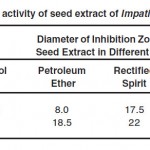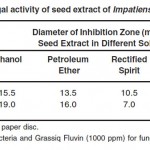Antimicrobial Activity of Seed Extract of Impatiens balsamina Linn
Basanti Jain1
DOI: http://dx.doi.org/10.12944/CWE.6.2.17
The world today due to changing food and living habits of human being is faced with the challenging problem of saving human life from various ordeal and naturally compells. Our ancient ayurvedic system of medicine is predominantly a plant based materia medica making use of our medicinal plants. Many herbal preparations have found their way in the pharmacoepea of other countries. The validity of claims of many of these preparations have been substantiated by modern scientific methods and techniques. Now these preparations are in active use in modern clinical practice.
The plant of this genera are valued for their emetic, cathartic, diuretic, antihaemorrhoidal and antibacterial properties. The seed extract of the plant was examined for antimicrobial activity and it has been found to possess remarkable antibacterial and antifungal activities.
Copy the following to cite this article:
Jain B. Antimicrobial Activity of Seed Extract of Impatiens balsamina Linn. Curr World Environ 2011:6;299-300 DOI:http://dx.doi.org/10.12944/CWE.6.2.17
Copy the following to cite this URL:
Jain B. Antimicrobial Activity of Seed Extract of Impatiens balsamina Linn. Curr World Environ [serial online] 2011;6:299-300. Available from: http://www.cwejournal.org/?p=1448
Download article (pdf)
Citation Manager
Publish History
Select type of program for download
| Endnote EndNote format (Mac & Win) | |
| Reference Manager Ris format (Win only) | |
| Procite Ris format (Win only) | |
| Medlars Format | |
| RefWorks Format RefWorks format (Mac & Win) | |
| BibTex Format BibTex format (Mac & Win) |
Article Publishing History
| Received: | 2011-11-15 |
|---|---|
| Accepted: | 2011-12-25 |
Introduction
The plant Impatiens Balsamina Linn1-3 (N.O. Balsaminaceae) is known Gulmendi in Hindi and is distributed throughout India. The seeds of this plant are edible. Alcoholic extract of the flowers has been found to have adequate antibiotic activity4 against scleroting, fructicola and other pathogenic fungi and bacteria. It is reported to be useful for pains in the joints.
The seeds of impatiens Balsamina Linn were extracted with respective solvents. The successive seed extracts of the plant were tested for their antimicrobial activity. The seed extract in various solvents have been found to possess promising antibacterial and antifungal activities.
Experimental
The seeds of Impatiens Balsamina Linn were collected locally and identified by Prof. Pramod Patil Botany Deptt., Govt. M.L.B. Girls College, Bhopal.
Air dried and powdered seeds were extracted with respective solvents i.e. ethanol, petroleum ether rectified spirit and ethyl acetate in soxhelet apparatus. These extracts were tested separately for antibacterial and antifungal activities respectively. Disc diffusion5-6 method was used for the purpose. The results in each case were expressed in terms of inhibition zones. The same procedure was repeated with control.
The microbial species selected for antibacterial activity are Bacillus anthracis and Escherichia coli and for antifungal activity Aspergillus niger and fusarium spe. are used.
Results and Discussion
Table A shows, that all the successive seed extracts have varying degree of antibacterial and antifungal properties. Ethanol and Rectified spirit extracts showed promising antibacterial activity against the growth of bacteria species whereas Ethanol and petroleum ether extracts showed better results against the fungal growth.
 |
Table 1: Antibacterial activity of seed extract of Impatiens balsamina Linn Click here to View table |
 |
Table 2: Antifungal activity of seed extract of Impatiens balsamina Linn Click here to View table |
Acknowledgements
The authoress is greatful to chairman UGC, New Delhi for awarding a minor research project; thanks are due to Director, CDRI, Lucknow for antimicrobial activity.
References
1. Chopra R.N., Chopra I.C. and Nayar S.L., “Glossary of Indian Medicinal Plants” C.S.I.R. Publication, New Delhi, 140 (1980).
2. “The wealth of India”, Raw material, C.S.I.R. Publication, New Delhi, 5, 168 (1959).
3. Kirtikar K.R. and Basu B.D., “Indian Medicinal Plants”, Indian Press, Allahabad, IInd ed., 445 (1918). REFERENCES
4. Giri S., Nizamuddin and Mishra A.K., Acta. Chim. Acad. Sci. Hung, 110: 117 (1982).
5. Gerhardt, P., Manual of methods for General Bacterialogy (American Society Microbiology, Castrello) (1981).
6. Ramana Rao, P.V., “Essentials of Microbiology 139 (2004).






